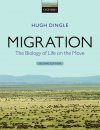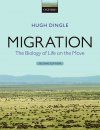![Migration Migration]()
Click to have a closer look
About this book
Contents
Customer reviews
Biography
Related titles
About this book
Migration, broadly defined as directional movement to take advantage of spatially distributed resources, is a dramatic behaviour and an important component of many life histories that can contribute to the fundamental structuring of ecosystems. In recent years, our understanding of migration has advanced radically with respect to both new data and conceptual understanding. It is now almost twenty years since publication of the first edition, and an authoritative and up-to-date sequel that provides a taxonomically comprehensive overview of the latest research is therefore timely.
The emphasis throughout this advanced textbook is on the definition and description of migratory behaviour, its ecological outcomes for individuals, populations, and communities, and how these outcomes lead to natural selection acting on the behaviour to cause its evolution. It takes a truly integrative approach, showing how comparisons across a diversity of organisms and biological disciplines can illuminate migratory life cycles, their evolution, and the relation of migration to other movements.
Migration: The Biology of Life on the Move focuses on migration as a behavioural phenomenon with important ecological consequences for organisms as diverse as aphids, butterflies, birds and whales. It is suitable for senior undergraduate and graduate level students taking courses in behaviour, spatial ecology, 'movement ecology', and conservation. It will also be of interest and use to a broader audience of professional ecologists and behaviourists seeking an authoritative overview of this rapidly expanding field.
Contents
Introduction
Part One: Migration and Methods for Its Study
1: Taxonomy of Movement
2: Migration: Definition and Scope
3: Patterns in Migratory Journeys
4: Methods for Studying Migration
Part Two: Proximate Factors in Migration
5: Migration, Winds, and Currents
6: Physiology of Migration
7: Biomechanical and Bioenergetic Constraints on Migration
8: Orientation and Navigation
Part Three: Migratory Life Histories and Their Evolution
9: Seasonal Migration Patterns
10: Migration to Special Habitats
11: Migration under Ephemeral Conditions
12: Behavioral and Life-History Variability in Migration
13: Polymorphisms and Polyphenisms
14: Evolutionary Genetics of Migration
Part Four: Migration and Human Biology
15: Human Interactions with Migration
16: Summing Up and Future Directions
References
Customer Reviews
Biography
Hugh Dingle is Professor Emeritus of Entomology and the Center for Population Biology at the University of California, Davis where he was a Director of the Animal Behavior Graduate Group. He is Past President and a Fellow of the Animal Behaviour Society and has a B.A. from Cornell and a PhD in Zoology from the University of Michigan. After postdoctoral work at the University of Cambridge (UK) and Michigan, Dingle went to the University of Iowa in 1964 moving to Davis in 1982. After retirement from UC Davis, he was an Honorary Research Consultant at the University of Queensland (Australia) from 2003-2010. He has conducted multi-taxon research on migration in North and South America, Africa, Australia, and Southeast Asia.
By: Hugh Dingle(Author)
329 pages, 3 plates with 5 colour photos; b/w photos, b/w illustrations, tables
"He provides a different perspective on migration because of his many detailed examples [...] Recommended. Graduate students through professional biologists."
– CHOICE
Reviews from the first edition:
"As a major contribution to a vital subject, this work will be valued by all the researchers and students in the fields of animal behaviour, ecology, and zoology."
– Ethology, Ecology, Evolution, Vol. 9, 1997
"The book is written in a highly readable style, and the author deals with the breadth and theoretical basis to his subject extremely clearly. [...] written in an uncomplicated style and could be understood by anyone with a serious interest in knowing more about the biological basis to migration."
– Glasgow Naturalist, Vol. 23, part 2, May 1997
"This book is an extremely comprehensive review of movement biology. The sections are closely written and not easily dipped into but read well as a whole or through an initial consideration of the chapter synopses [...] an excellent introduction to current ideas and concepts concerning the promotion and maintenance of a wide range of movement patterns. I recommend it to those who wish to have a broader understanding of migration than the movements of the Arctic Tern Sterna paradisaea."
– Ibis, 1997
"This book is an introduction and more to both the facts of migration, and also to the large body of discussion which has evolved around the subject. Dingle brings together a huge range of knowledge from a wide variety of fields to produce a fascinating new synthesis of migration. This work is well referenced and a pleasure to read, a highly commendable addition to any library. Highly recommended. "
– Gordon's Oxford University Press Review Page


































